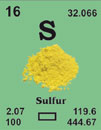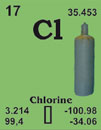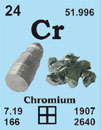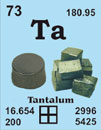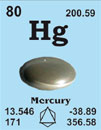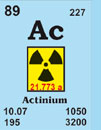Chromium single crystal 24Cr51.996
Discovered and isolated in 1780 by Nicholas Louis Vauquelin at Paris, France.
[Greek: chroma = colour]
French: chrome
German: chrom
Italian: cromo
Spanish: cromo
Description: Chromium is a hard, blue-white metal. It will dissolve in HCl and H2SO4 but not HNO3, H2PO or HClO4 due to reaction and formation of a protective layer on the surface. Chromium can be polished to a high shine and resists oxidation in air. It main uses are in alloys, chrome plating and metal ceramics.
Chromium single crystal properties
| State: |
Single crystal |
|---|
| Crystal structure: |
bcc |
|---|
| Production method: |
Floating zone |
|---|
| Standard size: |
diameter 6-10mm
thickness 1-2mm |
|---|
| Orientation: |
(100), (110) and (111) |
|---|
| Orientation accuracy: |
<2°, <1°, <0.4° or <0.1d° |
|---|
| Polishing: |
as cut, one or two sides polished |
|---|
| Roughness of surface: |
<0.03 µm |
|---|
| Purity: |
99.999% |
|---|
| Typical analysis (ppm): |
Ag < 0.10
C 10.0
Ca 0.01
Cd < 0.10
Cl 1.60
Co < 0.10
Cu < 0.10
Fe 18.0
H < 2.00
Mg < 0.10
Mn < 0.10
Mo < 0.20
N < 5.00
Na < 0.10
Ni 3.00
O < 5.00
Si 4.80
Cr balance |
|---|
Further Materials properties
| Crystal structure: |
(cell dimensions/pm), space group, b.c.c. (a=288.46), Im3m |
|---|
| X-ray diffractions mass absorption coefficients: |
CuKa 260 (µ/r) / cm2g-1
MoKa 31.1 (µ/r) / cm2g-1 |
|---|
| Neutron scattering length: |
0.3635 b/10-12 cm |
|---|
| Thermal neutron capture cross-section: |
3.1 sa / barns |
|---|
| Density: |
7.19 kg/m-3 |
|---|
| Melting point: |
1856.85 ±20 °C / 2130 ±20 °K |
|---|
| Boiling point: |
2671.85 °C / 2945 °K |
|---|
| Molar volume: |
7.23 cm3 |
|---|
| Thermal conductivity: |
93.7 [300 K] Wm-1K-1 |
|---|
| Coefficient of linear thermal expansion: |
6.2 x 10-6 K-1 |
|---|
| Electrical resistivity: |
12.7 x 10-8 [293 K] Wm |
|---|
| Mass magnetic susceptibility: |
+4.45 x 10-9(s) kg-1m3 |
|---|
| Young's modulus: |
279 GPa |
|---|
| Rigidity modulus: |
115.3 GPa |
|---|
| Bulk modulus: |
160.2 GPa |
|---|
| Poisson's ratio: |
0.21 |
|---|
| Radi: |
Cr4+ 56; Cr3+ 64; Cr2+ 84; atomic 1253 |
|---|
| Electronegativity: |
1.66 (Pauling); 1.56 (Allred); 3.72 eV (absolute) |
|---|
| Effective nuclear charge: |
3.45 (Slater); 5.13 (Clementi); 6.92 (Froese-Fischer) |
|---|
| Number of Isotopes (incl. nuclear isomers): |
13 |
|---|
| Isotope mass range: |
45 -> 57 |
|---|
Biological data
| Biological role: |
Essential to some species, including humans; it is also stimulatory. |
|---|
| Toxicity |
|
|---|
| Toxic intake: |
200 g |
|---|
| Lethal intake: |
metal, oral, human = 70 mg kg-1. LD50 (acetate, oral, rat) = 11000 mg kg-1 |
|---|
| Hazards: |
Chromium is a human poison by ingestion, it is also a suspected carcinogen. Chromates have a corrosive action on skin an tissue |
|---|
| Level in humans |
|
|---|
| Blood: |
0.006 - 0.11 mg dm-3 |
|---|
| Bone: |
0.1 - 0.33 ppm |
|---|
| Liver: |
0.02 - 3.3 ppm |
|---|
| Muscle: |
0.024 - 0.84 ppm |
|---|
| Daily dietary intake: |
0.01 - 1.2 mg |
|---|
Total mass of element in average
[70 kg] person: |
14 mg |
|---|
Geological data
| Minerals: | Many minerals are known, and aluminium is present in many other minerals |
|---|
| Mineral | Formula | Density | Hardness | Crystal apperance |
|---|
| Chromite |
FeCr2O4 |
4.7 |
5.5 |
cub., compacted, met. black |
| Chrocoite |
PbCrO4 |
6.0 |
2.5 - 3 |
mon., adam./vit. red-orange |
| Chief ore: |
chromite |
|---|
| World production: |
20000 tonnes/year (chromium metal); 9.6 x 106 (chromite ore) |
|---|
| Main mining areas: |
Turkey, South Africa, Zimbabwe, Rusia, Philippines. |
|---|
| Reserves: |
1 x 109 tonnes |
|---|
| Specimen: |
available as chips, chunks, crystallites or powder. Safe. |
|---|
| Abundances |
|
|---|
| Sun: |
5.13 x 105 (relative to H = 1 x 1023) |
|---|
| Earth's crust: |
c. 100 ppm |
|---|
| Seawater: |
|
|---|
| Atlantic surface: |
1.8 x 10-4 ppm |
|---|
| Atlantic deep: |
2.3 x 10-4 ppm |
|---|
| Pacific surface: |
1.5 x 10-4 ppm |
|---|
| Pacific deep: |
2.5 x 10-4 ppm |
|---|
| Residence time: |
10000 years |
|---|
| Classification: |
recycled |
|---|
| Oxidation state: |
VI |
|---|
Source: Emsley, J. (1998) The Elements (3rd Edition)
Other sizes and specifications on request

 English
English
 Deutsch
Deutsch
















